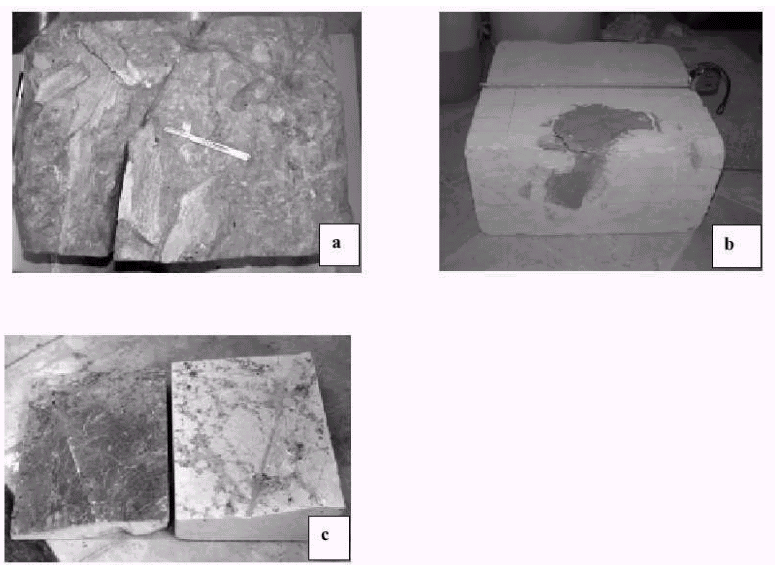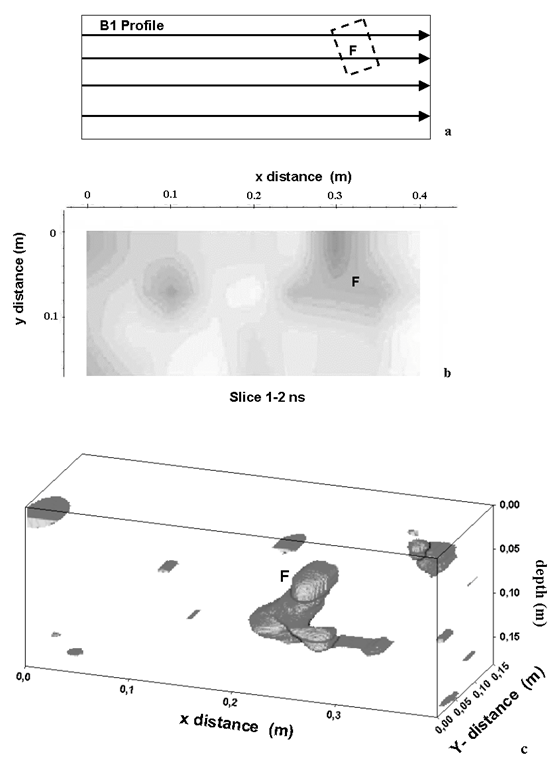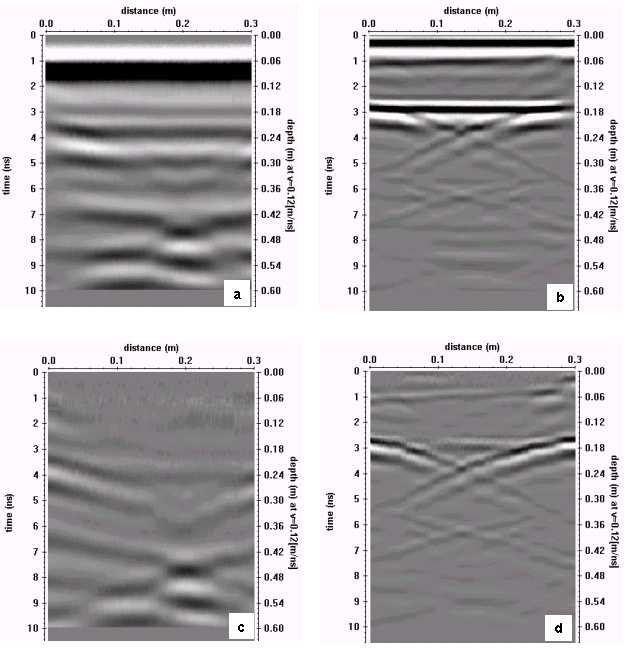-
Paper Information
- Next Paper
- Paper Submission
-
Journal Information
- About This Journal
- Editorial Board
- Current Issue
- Archive
- Author Guidelines
- Contact Us
Archaeology
2013; 2(2): 28-37
doi:10.5923/j.archaeology.20130202.03
A Ground Penetrating Test to Detect Vertebrate Fossils
Giovanni Leucci
Institute for Archaeological and Monumental Heritage, National Council of Research; Prov. Lecce-Monteroni, Lecce, 73100, Italy
Correspondence to: Giovanni Leucci, Institute for Archaeological and Monumental Heritage, National Council of Research; Prov. Lecce-Monteroni, Lecce, 73100, Italy.
| Email: |  |
Copyright © 2012 Scientific & Academic Publishing. All Rights Reserved.
In this study a palaeontological research method, based on the geophysical methodology known as Ground Penetrating Radar (GPR), is described. The geophysical investigation was undertaken with the purpose to verify the resolution capability of the GPR technique for the location of palaeontological remains with consequent saving of time and costs. In this paper the results of some tests carried out on biomicrite samples (with known position of the fossils) are reported. The tests have been performed on three biomicrite samples: glauconitic biomicrite, which is a variety of the Pietra Leccese, with a fragment of Cetotheride maxillary (Cetacea – Mysticete); biomicrite with cetacean vertebrae (Scaldiceto); normal biomicrite with part of Psephophorus Poligonus(Chelonide); all the samples date from the Middle Upper Miocene. Due to the samples dimensions the antennae with frequencies of 1000 MHz and 1500 MHz were used. Data were visualized in 3D that revealing the spatial position of highly reflecting bodies, such as the anomaly related to the fossil remains in the tests on the samples.
Keywords: Ground Penetrating Radar, Fossils, Vertical and Horizontal GPR Resolution
Cite this paper: Giovanni Leucci, A Ground Penetrating Test to Detect Vertebrate Fossils, Archaeology, Vol. 2 No. 2, 2013, pp. 28-37. doi: 10.5923/j.archaeology.20130202.03.
Article Outline
1. Introduction
- The opportunity to find underground structures, such as fossil remains, is particularly stimulating forpalaeontologists, in order to work in wide areas, where the existence of those remains is just a hypothesis.The GPR is a fast and cost-effective electromagnetic (EM) method which, in favourable conditions, i.e. mainly resistive non-magnetic environments, can provide valuableinformation on the shallow subsurface. Since it is based on the propagation and reflection of EM waves, it is sensitive to variations of the EM parameters in the subsoil, especially the dielectric constant and the electric conductivity[13]. Despite its relatively low penetration depth especially with high-frequency antennae and in moderately conductive environments), the GPR resolution capability (also depending on frequency and soil properties), by far greater than that obtained by other geophysical methods, makes this technique suitable for high-resolution shallow studies like archaeological applications and shallow stratigraphy mapping. The advantages to use the GPR technique for the finding of underground structures of archaeological and geological interest have already been discussed by several authors[10, 11, 12, 15, 16, 17, 18, 19, 21]. The advantages of GPR for the finding of palaeontological remains, are less well known; in fact, very few authors have studied this question[7, 8]. Purpose of this work is to verify the effective GPR resolution capability in order to employ it for the location of palaeontological finds with consequent saving of excavation time and costs. With this purpose, some tests were carried out on biomicrite samples (with known position of the fossils).The tests have been performed on:◆ glauconitic biomicrite, which is a variety of the Pietra Leccese, with a fragment of Cetotheride maxillary (Cetacea-Mysticete) ; ◆ biomicrite with cetacean vertebrae (Scaldiceto); ◆ normal biomicrite with part of Psephophorus Poligonus (Chelonide); The samples are dated in the Middle Upper Miocene. Due to the samples thickness, both the 1000 MHz and 1500 MHz antennae were used[1, 2, 3, 4, 5, 20], with particular attention on the data acquisition (parameters and geometries of acquisition). Because of the small size of the targets, the data were acquired in very close parallel profiles (0.05 m). Subsequently the data were processed by means of 1D and 2D techniques and visualized in 3D space not only by the standard time slice technique, but also by iso- amplitude surface of the complex trace amplitude. The use of 3D visualization techniques is of primary importance in palaeontological applications in order to display complex data in an easily understandable fashion, thus improving the quality and efficiency of the palaeontological interpretation. The most widespread way to display 3D radar data is in “time slice” (or depth slice) maps[11, 12]. Horizontal slices may not be the more suitable visualization technique in the case of great subsurface complexity since, for example, false amplitude anomalies can occur when the slicing planes cross dipping or undulating reflectors. However, time slices still remain the easiest and most rapid means to provide a synthetic view of the anomaly pattern, especially for large areas. For small-size zones a more complete understanding of the subsurface can be achieved by means of various 3D data presentations, including 3D cubes, chair views and slices parallel to the axes or along arbitrary directions. Interesting visualization approaches, involving the extraction and 3D visualization of the most promising signal attributes, have been proposed in recent papers[23, 24], where they have been successfully applied in imaging three dimensional bodies in mine detection and Non-Destructive testing applications.The quick revealing of the spatial position of highly reflecting bodies, such as the anomaly related to the fossil remains in the tests on the samples, makes 3D visualization technique very attractive in palaeontological applications of GPR. In the present study a trial of application of the 3D visualization techniques, along with classical time slice representation has been also made. The results obtained from the different situations encountered in this work are very interesting. The satisfactory performance of the GPR method in the palaeontological research is confirmed.
2. Samples Description
- The blocks investigated belong to two different varieties of Pietra Leccese, which is commonly represented by a biomicrite with calcareous cement, embedded in some places by thin marly levels.The samples labelled A and B in Fig. 1 have been collected in the basin located near Maglie (LE), in the area stretching between Cursi and Melpignano.
3. Data Acquisition
- Data acquisition is very important for a good geophysical survey. In fact, the acquisition parameters directly influence the data quality, and so all the following processing; therefore this choice must be very accurate and it must be done bearing in mind the aims of the investigation.The choice of the antennae is equally important, because, as already said, the penetration depth and the GPR resolution capability depend on the electromagnetic pulse frequency. Besides, it is necessary to remember that the different lithostratigraphical formation and physical features have peculiar effects on the radar sections[22] (reflection width and continuity, unity geometry, dominant frequency, diffraction presence and degree of penetration). Therefore, some preliminary measurements were made to estimate the best acquisition parameters. A reconnaissance survey was made in continuous mode, in a rectangular area along 0.05 m spaced parallel profiles.
4. Data Analysis
- Block ABlock A, widely described in paragraph “Sample Description”, has the following dimensions: 0.4 m wide, 0.3 m high and 0.35 m thick. The fossil fragments lie at about 0.22 m in depth (Fig. 3a). The GPR survey was carried out in a rectangular area of 0.4 m by 0.3 m, along 0.05 m spaced parallel profiles using the 1000 MHz antenna in single-fold continuous mode (Fig. 3b). The most accurate and straightforward method of estimating the EM wave propagation velocity in a medium, is to identify reflections in GPR profiles that are caused by objects of interest that occur at known depths. This method allows for a direct determination of the average velocity of EM waves from the surface antenna to a measured depth. The knowledge of both the block dimensions and the fossil remains position has allowed to estimate the average EM wave propagation velocity. In fact, the two – way travel time (t) from the surface to the fossil remains and back to the surface was measured at about 6.2 ns, and the measured depth (s) to the fossil remains was 0.22 m. The equation v=2s/t can be used to calculate the EM wave velocity in the block A which was 0.07 m/ns.The quality of the raw data did not require advanced processing techniques. In fact only horizontal scaling normalisation and background removal filter have been performed for an easier interpretation. The application of the migration has not been particularly resolutive, since in the data there were nearly no diffraction hyperbolae. Consequentely, the migration has been omitted from the data processing.
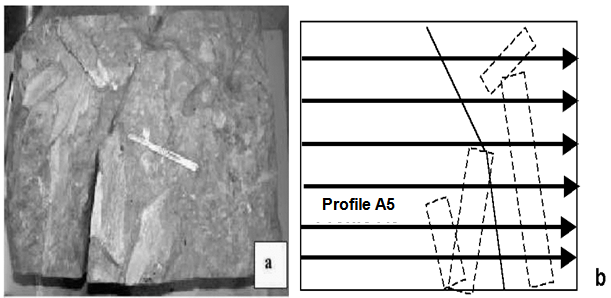 | Figure 3. Block A: a) photo; b) drawing of the side, with localization of the radar profiles and the fossil fragments |
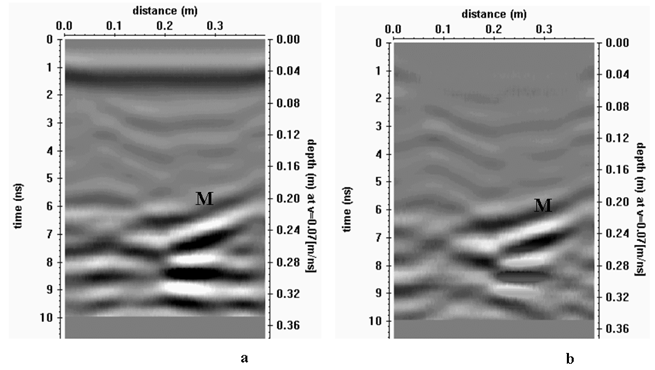 | Figure 4. Radar section relating to profile labelled A5 in Fig. 3: a) raw data; b) processed data |
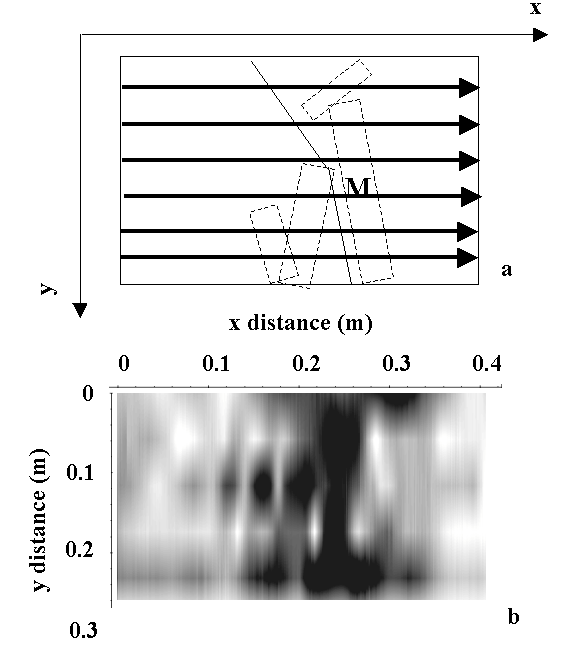 | Figure 5. Block A: a) drawing of the side, with localization of the radar profiles and the fossil fragments; b) time slices 6-8 ns |
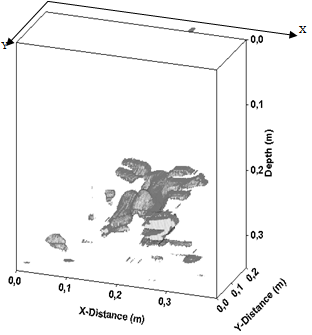 | Figure 6. Block A: 3D visualization by means of iso-amplitude surface of the complex trace amplitude using a 50% threshold. The anomaly related to the fossil remains is better emphasised |
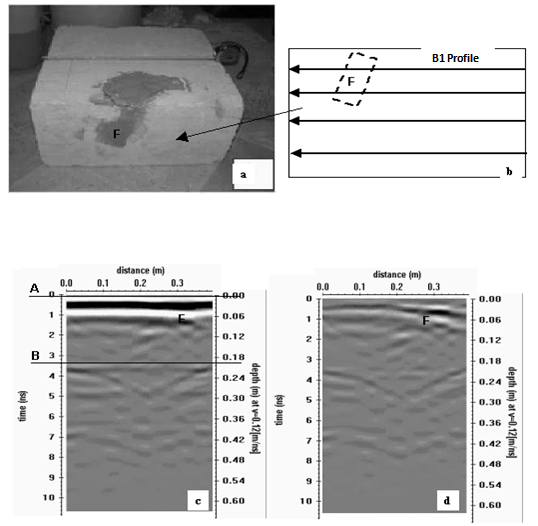 | Figure 7. Block B: a) photo; b) drawing of the side, with localization of the radar profiles and the fossil fragments; c) raw radar section relating to profile labelled B1; d) processed radar section |
 | Figure 9. Block C: a) photo; b) drawing of the side, with localization of the radar profiles and the fossil fragments |
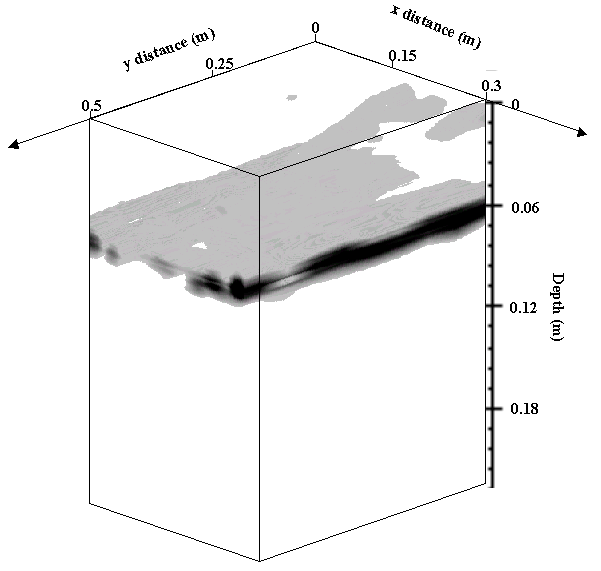 | Figure 11. Block C: 3D visualization by means of iso-amplitude surface of the complex trace amplitude using a 50% threshold |
5. Conclusions
- The geophysical investigation described in this work, aims to verify the potentiality of the GPR method to locate underground structures, such as fossil remains, at a depth of a few metres.The response of the methodology, relating to the two units (blocks A and B-C) containing the fossil fragments has been very different: in fact, it mirrors the different electromagnetic and geolithological features of the investigated formations; inside blocks B-C, belonging to the same geolithological formation, the EM wave propagates without significant attenuation, while, inside block A the EM wave attenuation is slightly higher. This necessitates an accurate choice of the antenna; this choice is bound to the resolution, and so to the size of the structure to locate, and to the penetration depth. However, the survey showed the presence of fossil remains inside the blocks investigated. Therefore, the technique offers a good response. Furthermore the primary importance of 3D visualization comes from the fact that it can provide a powerful and intuitive means of communicating complex information to non-geophysicists. Aside from the paleontological meaning of the features imaged, the present study allowed also a comparison of the performance of different visualisation techniques of GPR data. Time slice maps, used mainly to enhance the horizontal relationships between amplitude anomalies, showed some alignments related to the fossil remains. Obviously this method failed in imaging dipping events as in the block C where there is an inclined surface that represents the fossil remains. They are more objective representation of the results than the other methods explored, but do not furnish an instantaneous view of the entire volume with the same immediacy.The 3D contouring and isoanomaly plotting suffered from a certain degree of subjectivity in selecting the threshold value, but furnished very impressive pictures of 3D (and to a lesser degree also 2D or 1D) reflecting bodies, provided the data had a relatively high S/N ratio.
ACKNOWLEDGMENTS
- The author wishes to thank Dr. Lara De Giorgi, for her useful co-operation during the data acquisition.
 Abstract
Abstract Reference
Reference Full-Text PDF
Full-Text PDF Full-text HTML
Full-text HTML